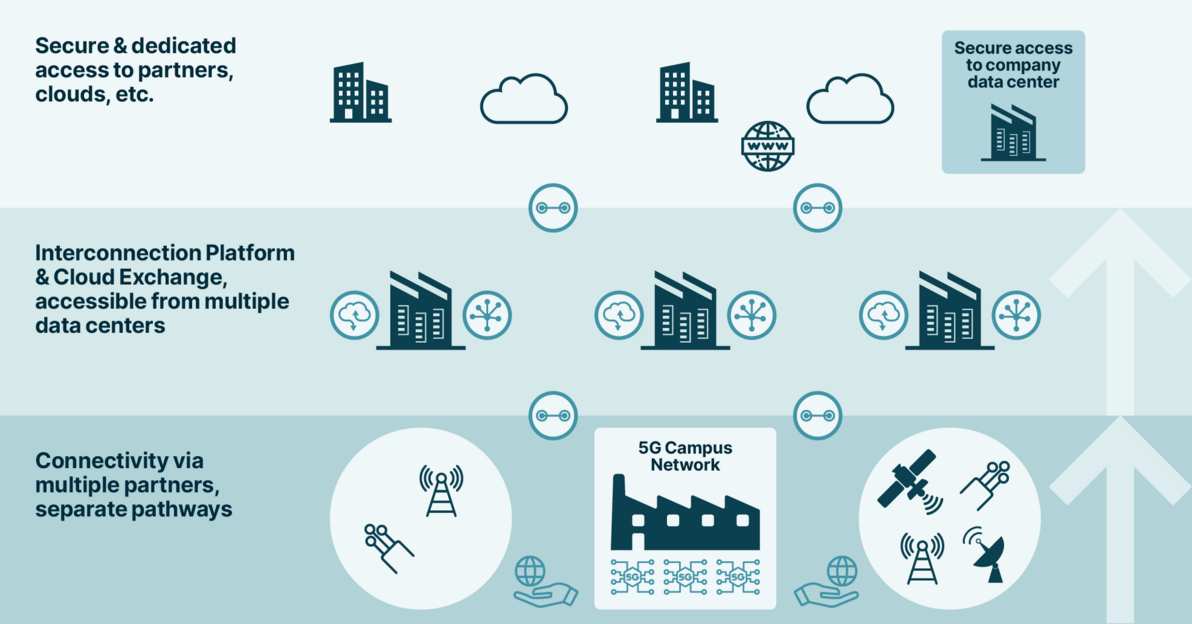The 5G campus network has become big news in the manufacturing industry. The first operational campuses came online in 2019 in China, and research campus networks have demonstrated the potential of the technology. German airline carrier Lufthansa was among the pioneers of the 5G campus network, having set up their test bed shortly before the Covid-19 pandemic hit, and reaping the rewards of their forward-thinking as it became suddenly an essential and productive interface for technical inspections. In the meantime, automotive OEMs like BMW, Mercedes-Benz, VW, and Ford have announced their plans to build their own 5G campus networks, at least for testing purposes. However, many of these plans are yet to bear fruit, so it’s still early days for the factory of the future.
5G is a game-changer in terms of the amount of data that can be transmitted over a mobile network, as well as the number of devices that can be connected: 5G can enable peak data rates of up to 20 Gbit/s, with up to 1 million devices connected per km2, and data transmission is highly reliable, with a latency of as low as single millisecond. Looking at the alternatives, even the newest Wi-Fi generation, WiFi 6, has major disadvantages compared to 5G for the manufacturing scenario. Certainly, OEMs also operate WiFi networks today, and Wi-Fi 6 enables higher bandwidths than its predecessors. However, WiFi 6 is more aimed at getting high bandwidths through for more domestic use cases like video streaming in 4K. The advantage of 5G is that it also enables much lower latency (reaction times) and therefore higher transmission speeds. The cells can also be larger: Whereas WiFi 6 is more targeted at the home market and enables connectivity for the dimensions of around 100m2, 5G enables cells in the realm of several hundred meters in every direction, making it much more suitable for smart factories and production plants.
What makes 5G so interesting for manufacturing? The special requirements of a whole range of modern smart factory solutions depend on the combination of low latency and high bandwidth connectivity, and the nature of a campus environment means that this connectivity should be wireless. The smart factory of tomorrow demands seamless, utterly reliable, high-bandwidth and low-latency communications between hundreds, if not thousands, of sensors, machines, AI capabilities, and multiple external networks – just for a single campus to function. Dr. Thomas King, CTO at DE-CIX, the leading operator of carrier and data center neutral interconnection platforms in the world, has put together five trends in the manufacturing sector which demonstrate the potential of 5G connectivity.
1. Digital Twins for simulation, designing and testing
A digital twin is pretty much exactly what its name suggests: a virtual model of a product, system, or process for the purposes of simulations, designing, and testing. Spearheaded by the manufacturing, automotive, and aviation industries, the use digital twins is predicted to increase tenfold by 2030. By 2027 it is forecast that over 90% of all IoT Platforms will be capable of some form of digital twinning. Data-driven twins of machinery, for example, rely on up-to-the-minute data from the real-world machinery, and can be used to carry out predictive maintenance, enabling the replacement of parts before faults become apparent. Equally, systems involved in supply chains can be modelled in order to identify bottle necks and optimize inventories. These digital twins depend on data generated by sensors on the real-world machines, which must then be fed into the simulation.
2. Robotics as a Service (RaaS) to reduce (up-front) investments
The automotive sector was a trailblazer in robotics for manufacturing, with enormous investment in automated production plants. As other sectors start to catch up, the need for lower investment hurdles has seen increasing interest in Robotics as a Service, in which the robotics manufacturer not only leases the machines to a manufacturer, but operates, monitors, and services them remotely. For such use cases, high bandwidth and low latency connectivity is required between the machines on the factory floor and the data center of the robotics operator, so that telemetry data, as well as high-resolution images and video, can be transferred.
3. Remote maintenance – safety first, even from afar
The German airline company Lufthansa was one of the pioneers in establishing a productive 5G campus network for their Engine Services business unit, which they had fortuitously set up in early 2020. Previous attempts at using WiFi solutions had resulted in inadequate image quality, which did not allow for precise diagnostics. The greater bandwidth and low latency of 5G made it possible for high-resolution photos and videos to be made available to customers, making the move to remote table inspections – brought about by the Covid-19 pandemic – a possible and workable alternative to the on-site inspections usually preferred by customers.
4. Virtual and augmented reality
A further use-case from Lufthansa is their augmented reality (AR) project for the display of customizable design elements such as furniture against the live video image of the cabin interior for customized, high-end VIP interiors. Equally, customization is beginning to take off in the automotive industry for the purposes of e.g. enabling far greater individualization in the design of EVs on the basis of a standard chassis to which varying body shapes and interiors can be added. This customization is powered by virtual reality (VR), allowing the end-customer to experience and alter the design, with the customized body parts then being produced through – although still in its early days – additive manufacturing, or 3D printing. To enable end-user capabilities for VR-based customization, an immersive simulation (a digital twin in VR) of the product concerned needs to be made available publicly. This requires extremely high bandwidth and low latency connectivity between the company’s data center (or the cloud from which the simulation is sourced) and end-user access networks. Such high-performance connectivity has previously only been available to end users via fiber connections – but 5G will also enable immersive experiences via mobile connectivity.
5. Intelligent and autonomous logistics
Business consultancy Gartner forecasts that the warehouse operations of 75% of large enterprises will entail some form of intralogistics smart robots by 2026, and these will need to communicate with each other and be managed via 5G. Outside of company premises, however, 5G will have an even greater impact on logistics, through ensuring supply chain visibility and allowing real-time tracking of consignments in transit. The enablement of autonomous vehicles (AVs) is a further aspect where 5G is revolutionizing logistics – with the first testbeds for autonomous trucks and logistics systems up and running. The Covid-19 pandemic brought with it painful lessons that relying solely on just-in-time deliveries is not always expedient, and that companies should aspire to greater control over their supply chains. By linking intelligent logistics to company resources like ERPs, inventories, and supply chain management systems, greater insights and controllability will become possible.

